The NZXT N7 Z490 Motherboard Review: From A Different Direction
by Gavin Bonshor on October 7, 2020 10:30 AM EST- Posted in
- Motherboards
- Intel
- ASRock
- NZXT
- Z490
- Comet Lake
- Intel 10th Gen
- i7-10700K
- N7 Z490
Gaming Performance
For Z490 we are running using Windows 10 64-bit with the 1909 update.
Grand Theft Auto V
The highly anticipated iteration of the Grand Theft Auto franchise hit the shelves on April 14th 2015, with both AMD and NVIDIA in tow to help optimize the title. GTA doesn’t provide graphical presets, but opens up the options to users and extends the boundaries by pushing even the hardest systems to the limit using Rockstar’s Advanced Game Engine under DirectX 11. Whether the user is flying high in the mountains with long draw distances or dealing with assorted trash in the city, when cranked up to maximum it creates stunning visuals but hard work for both the CPU and the GPU.
For our test we have scripted a version of the in-game benchmark. The in-game benchmark consists of five scenarios: four short panning shots with varying lighting and weather effects, and a fifth action sequence that lasts around 90 seconds. We use only the final part of the benchmark, which combines a flight scene in a jet followed by an inner city drive-by through several intersections followed by ramming a tanker that explodes, causing other cars to explode as well. This is a mix of distance rendering followed by a detailed near-rendering action sequence, and the title thankfully spits out frame time data.
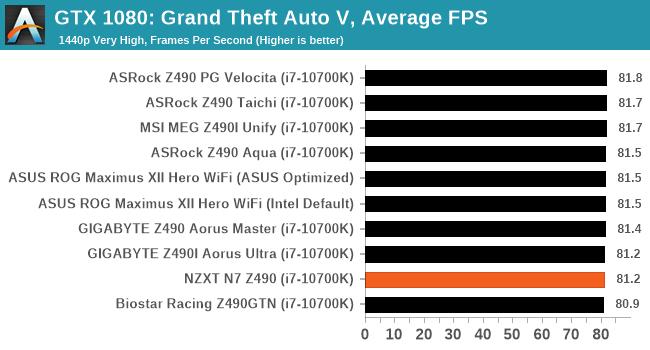
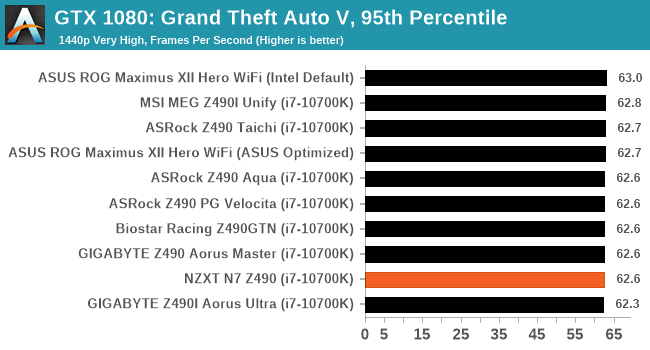
F1 2018
Aside from keeping up-to-date on the Formula One world, F1 2017 added HDR support, which F1 2018 has maintained; otherwise, we should see any newer versions of Codemasters' EGO engine find its way into F1. Graphically demanding in its own right, F1 2018 keeps a useful racing-type graphics workload in our benchmarks.
Aside from keeping up-to-date on the Formula One world, F1 2017 added HDR support, which F1 2018 has maintained. We use the in-game benchmark, set to run on the Montreal track in the wet, driving as Lewis Hamilton from last place on the grid. Data is taken over a one-lap race.
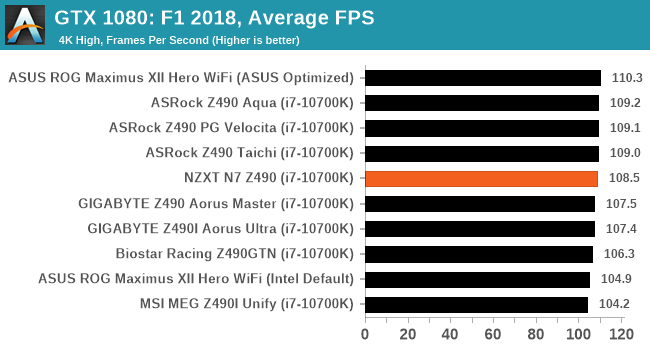
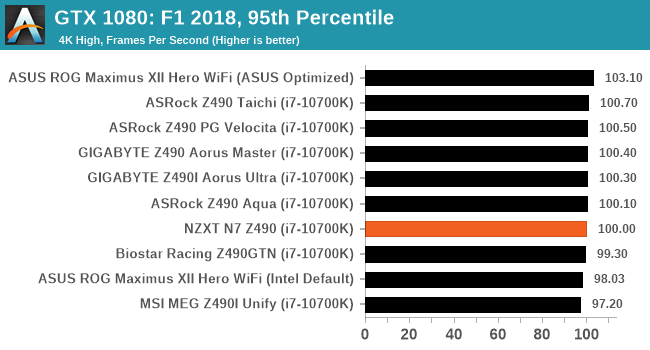
Strange Brigade (DX12)
Strange Brigade is based in 1903’s Egypt and follows a story which is very similar to that of the Mummy film franchise. This particular third-person shooter is developed by Rebellion Developments which is more widely known for games such as the Sniper Elite and Alien vs Predator series. The game follows the hunt for Seteki the Witch Queen who has arose once again and the only ‘troop’ who can ultimately stop her. Gameplay is cooperative centric with a wide variety of different levels and many puzzles which need solving by the British colonial Secret Service agents sent to put an end to her reign of barbaric and brutality.
The game supports both the DirectX 12 and Vulkan APIs and houses its own built-in benchmark which offers various options up for customization including textures, anti-aliasing, reflections, draw distance and even allows users to enable or disable motion blur, ambient occlusion and tessellation among others. AMD has boasted previously that Strange Brigade is part of its Vulkan API implementation offering scalability for AMD multi-graphics card configurations.
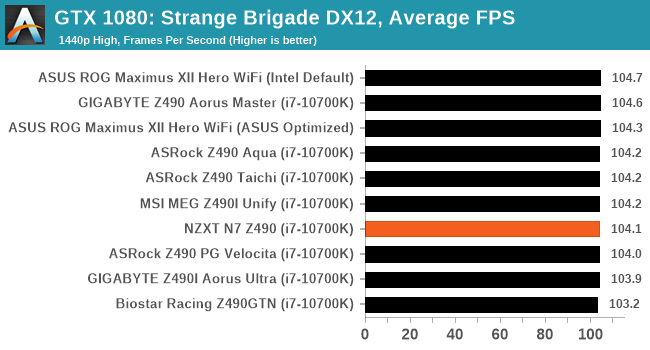
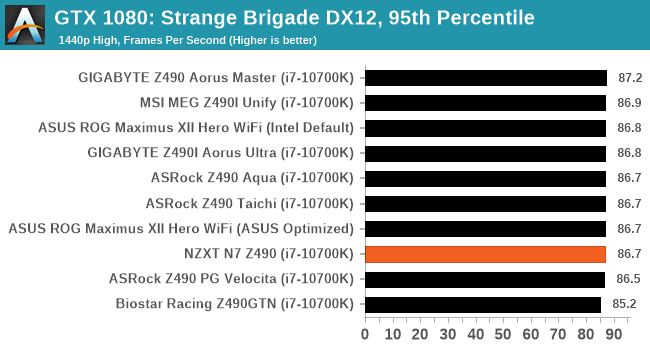













45 Comments
View All Comments
Gigaplex - Wednesday, October 7, 2020 - link
Can we please stop calling these stupid shrouds that trap heat "armor"?stephenbrooks - Thursday, October 8, 2020 - link
When I saw this I was hoping it was all metal and the components all had heatsinks bonded to it (so it acts as a huge heat sink), but obviously not...s.yu - Thursday, October 8, 2020 - link
All plastic would be thoroughly disappointing.AlexTopfer - Wednesday, October 7, 2020 - link
What does this 'armour' do? And why do you need to armour a motherboard, wouldn't you armour the case?Or is it designed to protect against spalling inside an armoured cases?
Can you please test the armour too? What caliber will it protect against?
Tomatotech - Friday, October 9, 2020 - link
It’s for looks. Just like tacti-cool.My PCs are little black or silver ITX boxes, but if I was building an art piece I’d be tempted to use something like this if I wasn’t going for the cables everywhere junk-punk style.
wolfman3k5 - Thursday, October 8, 2020 - link
They're mediocre junk. Gigabyte, ASUS or MSI, even EVGA, they all make decent motherboards. NZXT should stick to cases, LEDs and AIOs.selenite - Thursday, October 8, 2020 - link
The motherboard, including SSDs is covered in metal and plastic, restricting the airflow to the board's surface, PCH heatsink and SSDs/SSD heatsinks. VRM heatsinks, hollowed out to improve the airflow, but no actual fan that would send some air into what appears to be an L-shaped duct. All of this prettiness is inside the case.A hideous cutout for the USB-C connector at the back. That one is outside the case.
¯\_(ツ)_/¯
Tomatotech - Friday, October 9, 2020 - link
Ouch that C cutout is terrible. It looks like it might be for some kind of locking USB-C connector but I can’t find anything that would fit it. Hopefully they will fix it in a revision.I have an ancient cheap gigabyte ITX mobo with an i3-6100 in it that has a perfectly formed usb c connector & cutout in the backboard. It isn’t hard.
nunya112 - Thursday, October 8, 2020 - link
Asrock will probably blacklist you for not being 100% positive in this review. Just wanted to let you know :)hanselltc - Thursday, October 8, 2020 - link
Wrong platform, wrong time, and definitely the wrong feature set -- at least when you only count the working features.